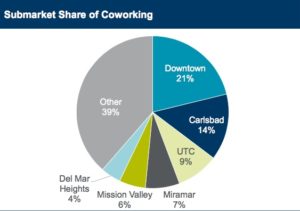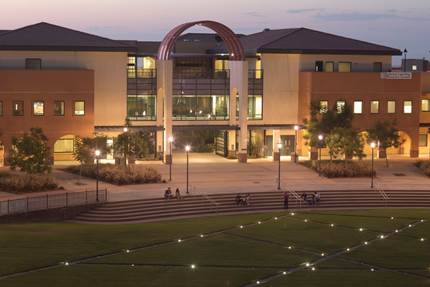Daily Business Report-June 17, 2019
Coworking continues to gain popularity among tech startups and creatives.
Coworking office space grows to
1.5 million square feet in San Diego
In San Diego, there are over 1.5 million square feet (msf) of coworking spaces across 107 locations, representing 1.9 percent of the 80 msf of the total office inventory countywide, compared to 1.2 msf across 90 locations a year ago, according to Cushman & Wakefield’s Coworking & Flexible Workplaces report.
This compares to a 1.1 percent average of coworking inventory nationwide and 2.5 percent average in gateway markets.

Coworking continues to gain popularity among tech startups and creatives such as marketing and web design companies along with freelancers and independent contractors, representing various employment sectors. Physical and financial flexibility are becoming the new “normal” for the twenty-first century workforce, and co- working supports these needs.
Downtown San Diego has the largest share or 21 percent of coworking inventory, anchored by WeWork’s 88,000-square-foot location at 600 B St. Carlsbad has the second largest share (14 percent) and has the highest number of locations (16) ranging from 3,500 square feet to 41,300 square feet. Over 1.2 msf of existing coworking space or 83 percent of the total inventory have opened since 2011. A number of providers are seeking to expand their footprint in San Diego, hoping to ink deals within the next year.
Downtown coworking inventory is expected to grow as Regus opens Spaces locations at Makers Quarter and at Kettner & Ash this year. Industrious will also open its first location in San Diego at 1 Columbia Place this year.
Regus has the most space (19 percent) in San Diego, with 288,300 square feet across 18 locations followed by Premier Workspaces (10 percent) with 152,100 sf across 9 locations and WeWork (9 percent) with 140,600 square feet across two locations.
A number of specialized coworking locations have taken root in San Diego, focusing on major local industries, such as life sciences and technology as well as film production, legal services, nonprofits, medical and supporting female entrepreneurs.
____________________

Miramar College awarded $1.4 million
contract by California Energy Commission
San Diego Miramar College received a $1.4 milllion contract from the California Energy Commission to assist with the development of an alternative fuels and advanced vehicle technology workforce training program. The San Diego Community College District Board of Trustees accepted the contract at its June 13 board meeting.
The Alternative Fuel and Vehicle Training Enhancement Program (ARFVTP) with the California Energy Commission delivers workforce training related to advanced energy technology designed to reduce air pollution, and provides state-of-the-art equipment. The program also builds partnerships with employers, labor unions, labor management partnerships, community organizations, workforce investment boards, community colleges, and economic development agencies. San Diego Miramar College was the original recipient of this contract.
The contract will develop and fund advanced transportation workforce training through the California Community Colleges automotive technologies programs. The Advanced Transportation & Logistics (ATL) Initiative will publish opportunities to fund alternative fuel and advanced vehicle technology proposals across the California Community Colleges. The ATL Initiative will focus on increasing the participation of veterans and persons living in underserved and disadvantaged communities.
____________________

Marine Corps looks to buy General
Atomics’ MQ-9 Reapers to take new missions
ExecutiveGov
The U.S. Marine Corps wants to make the General Atomics-made MQ-9 Reaper unmanned aerial systems permanent in its inventory through the fiscal year 2020 budget proposal, National Defense Magazine reported. The service requested $117 million in funding to buy three Reapers in the coming year and additional three for fiscal year 2021.
Officials said the UAS will enable the Marines to bring new weapons to the field and conduct missions currently unsupported by its existing systems. Capt. Christopher Harrison, a spokesperson for the Marine Corps, said the service currently operates the Reapers under a contractor-owned, contractor-operated agreement.
“The MQ-9 Reaper provides increased lethality to the Marine Air-Ground Task Force by providing persistent intelligence, surveillance and reconnaissance and strike capability, which the Marine Corps has not previously possessed in an unmanned system,” Harrison said.
Bryan Clark, a senior fellow at the Center for Strategic and Budgetary Assessments, said the drones would support the service in surveillance and electronic warfare in the South China Sea, armed reconnaissance in Iraq, Afghanistan, Syria and Africa and power competition against Russia and China.
Congress has yet to approve the funding for the FY20 budget proposal.
____________________

Sundt Construction Inc. begins work on
transformation of Emerson-Bandini Elementary
Sundt Construction, Inc. (www.sundt.com) recently began demolition at Emerson-Bandini Elementary, beginning the initial phase of a total site transformation.
Sundt will construct a 22,000-square-foot, two-story wing of classrooms; a 5,200-square-foot administrative workspace; new classroom halls for both kindergarten and preschool; a new outdoor amphitheater and a cafeteria.
“We’re excited to build an atmosphere that will help educate and inspire kids for years to come,” said Jared Mettee, Sundt’s project manager. “This work is at the heart of our company’s purpose: to build environments where our clients, employee-owners and communities prosper.”
The team will also fully refurbish the multi-purpose building, which is comprised of a multi-purpose room, library media center, cafeteria and kitchen. Exterior improvements include reshaping the existing turf field and expanding it to over 26,400 square feet.
The initial phase of demolition is expected to complete by fall of this year, with the project set to finish in winter 2021. The project is fully funded through the San Diego Unified School District’s Propositions S and Z.
____________________
San Diego Community College District
adopts $634 million tentative budget
The San Diego Community College District (SDCCD) has a new, tentative spending plan of $634 million for the 2019-20 fiscal year that balances student access with meeting system-wide challenges such as a new funding formula and increasing pension obligations. The SDCCD’s Board of Trustees adopted the budget at its June 13 meeting.
The tentative budget is used to inform planning for the upcoming academic year at City, Mesa, and Miramar colleges as well as San Diego Continuing Education. Tentative budgets must be adopted by June 15 and a final adopted budget must be approved by the Board of Trustees in September. The district’s new fiscal year begins July 1.
General Fund spending that is not restricted to specific programs is down slightly at nearly $312 million, with the total General Fund projected at $443 million – a decrease of $5.2 million or 1.16 percent over last year. Total overall spending, of $634,411,592 represents a decrease of nearly 7 percent from the previous year, a drop primarily due to the winding down of the voter-approved, $1.55 billion Proposition S and N bond program that has financed unprecedented construction at San Diego City, Mesa, and Miramar colleges and Continuing Education.
The 2019-20 budget year will be the second under California’s controversial “Student Centered Funding Formula” for community colleges. Under the new formula, 70 percent of state dollars are based on enrollment, with 20 percent based on the number of low-income students enrolled in a district, and 10 percent based on student performance outcomes. Previously, budgets were based on enrollment. The SDCCD estimates it has lost millions in potential revenue due to the new formula and has had to limit its enrollment to ensure a balanced budget.
____________________
Personnel Announcements
Joseph von Meier elected newest partner at
Crosbie Gliner Schiffman Southard & Swanson

Crosbie Gliner Schiffman Southard & SwansonLLP (CGS3), a San Diego-based commercial real estate law

firm, announced it has elected Joseph von Meier as its newest partner. Von Meier joined CGS3 in 2017 as senior counsel and will continue to work from the firm’s San Diego offices.
Specializing in commercial real estate law with an emphasis on development and construction related
transactional matters, von Meier represents clients from across the country – concentrating his practice on high-profile, complex real estate transactions with a focus on student housing, multifamily, luxury residential and retail development and construction
Joe launched his career at Chicago-based Burke, Warren, MacKay & Serritella PC where he worked for nearly 15 years and rose to Partner. During his tenure with Burke, Warren, he served as in-house counsel for a prominent Chicago-based development and construction company as well as an award-winning, national student housing developer, where he oversaw financing, construction, and operations‑related matters.
____________________

Change of Command at North Island
Rear Adm. Dave Welch, from Peoria, Ill., relieves Rear Adm. Bill Byrne, from Pacifica, as commander of Carrier Strike Group 15 during CSG-15’s change of command ceremony at Naval Air Station North Island, June 13. (U.S. Navy photo by Mass Communication Specialist 3rd Class Jailene Casso)


